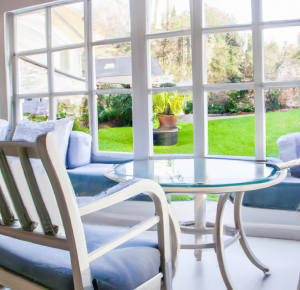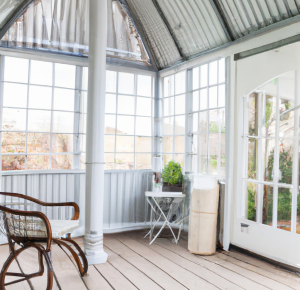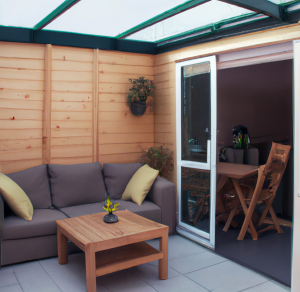Is it worth converting a conservatory?
When considering whether to renovate or replace a conservatory, many individuals opt for the former. Renovating a conservatory is a popular choice as it offers several advantages. Firstly, it is a more cost-effective approach to breathe new life into your living space.
Additionally, renovation projects are often less disruptive compared to demolishing and replacing the entire structure.

Furthermore, renovating a conservatory is unlikely to require obtaining planning permission, saving you time and potential bureaucratic hurdles.
Therefore, converting and refurbishing a conservatory is a worthwhile option to consider for homeowners seeking to enhance their space without incurring excessive costs or inconvenience.
Can I convert a conservatory into a room?
Absolutely! Converting an existing conservatory into a garden room or constructing a separate freestanding structure is a viable option.
Unlike conservatories, garden rooms typically feature a tiled roof instead of a glazed roofing system, giving them a seamless integration with the house. The choice of tile color and style can be tailored to complement the existing roof tiles.
While there may be a slight reduction in natural light, this can be mitigated effectively. The tiled roof is excellent at regulating temperature, ensuring a comfortable interior environment.

Moreover, a garden room offers versatile functionality, serving as a kitchen, games room, lounge, TV room, dining room, or office.
Similar to an orangery, garden rooms often have a brickwork base with expansive glazed panes. The name itself suggests the advantage of enjoying beautiful garden views. For added style and access to the garden, bi-folding doors, French doors, or patio doors can be incorporated into the design.
Additionally, incorporating an overhanging roof in the front projection creates a shaded outdoor space to relax in.
Can I convert a conservatory?
Converting a conservatory into an orangery or extension is indeed possible, but it’s a task that requires careful consideration and adherence to Building Regulations.
Typically, fulfilling the requirements set by local authorities entails the construction of an entirely new structure.

To determine the feasibility of such a conversion, a surveyor would need to visit your property and assess both the existing conservatory and the desired conversion.
This assessment is crucial to ensure compliance with regulations and to make informed decisions regarding the conversion process.
Is it cheaper to turn a conservatory into an extension?
The cost of turning a conservatory into an extension is variable and dependent on several factors such as material choices, the size of the area, and additional features desired.
While it is generally true that building a conservatory is often less expensive than constructing a full extension, the actual cost will vary case by case.

Factors such as the quality of materials used and the complexity of the conversion project can influence the overall expenses.
Therefore, it is important to evaluate specific requirements and consult with professionals to obtain accurate cost estimates when considering the conversion of a conservatory into an extension.
What are the rules for conservatory in the UK?
In the UK, there are specific regulations governing the construction of conservatories. For rear conservatories, their height cannot exceed four meters.
However, if the conservatory is located within two meters of the property boundary, its height must be three meters or less.

When it comes to side conservatories, they cannot be wider than 50% of the original house’s size.
These regulations are in place to ensure compliance with building standards and maintain appropriate proportions in relation to neighboring properties. It is important to be aware of these rules when planning to build a conservatory in the UK.
Are conservatories going to be banned in the UK?
No, you do not have to get rid of your existing conservatory. The new rules that restrict the height and size of conservatories apply only to new build developments starting from June 2022.

If you already have a conservatory or are planning to build one to expand your current home in the future, these changes will not affect you. Therefore, conservatories will not be banned in the UK; the regulations primarily impact new constructions.
Can I use my conservatory as a bedroom?

Certainly! A conservatory can indeed serve as an excellent extra bedroom, especially for sleepovers or accommodating guests. However, it’s important to note that converting a conservatory into a bedroom requires careful planning and consideration, especially if it will be used as a permanent sleeping space.
There are several practical factors to address before transforming the conservatory into a functional bedroom.
Ventilation is a key consideration as conservatories are often not well ventilated, leading to condensation and potential issues with dampness and mold. In such cases, a conservatory roof conversion may be necessary to create a suitable living environment.
Heating and insulation are additional concerns. Due to poor ventilation and insulation, conservatories can become excessively hot in summer and cold in winter.

Electric heaters are commonly used to address this issue, but double or triple glazing the windows and implementing draft-excluding measures can help retain heat. Adding a thermal underlay beneath the flooring can also prevent heat loss.
Noise is another factor to consider, as conservatories made of glass or polycarbonate materials may not offer soundproofing. If the conservatory is located near a noisy area or a busy road, it might not be ideal for use as a bedroom.
Additionally, the weather should be taken into account, particularly in the UK where rainy days can create a significant noise level in a conservatory. While some individuals may find the sound relaxing, others may not appreciate sleeping through a heavy downpour on the glass roof.
In summary, using a conservatory as a bedroom is possible, but it requires addressing ventilation, heating, insulation, noise, and weather conditions to ensure a comfortable and suitable sleeping environment.
What is the lifespan of a conservatory?

The lifespan of a standard conservatory used to be around ten years, but advancements in installation methods, materials, and maintenance practices have significantly increased its longevity. With experienced fitters, high-quality materials, and proper care, a uPVC conservatory can now last approximately 25 years or even longer.
To ensure your conservatory is worth the investment and to extend its lifespan, there are several factors to consider. When evaluating the quality of a conservatory, it’s important to assess the frames, roofing, glazing, and doors.
Conservatory frames, available in materials like wood, aluminium, and PVCu, should be chosen for durability and aesthetic appeal. Opting for sculptured PVCu frames made with high-quality raw materials ensures long-lasting performance and resistance to discoloration.
Reinforced with mitred fusion welded joints and featuring a multi-chambered structure, these frames offer both structural strength and energy efficiency.

Choosing high-quality roofing materials, such as lightweight aluminium or PVCu frames, can reduce the risk of leaks and further prolong the conservatory’s lifespan. When deciding between polycarbonate plastic roof panels and double-glazed glass roof panels, the latter tends to offer superior longevity, appearance, and insulation.
The choice of glazing is crucial as well. Opting for double glazing that incorporates the latest glass technology, such as reflective surfaces and insulated panels, enhances the longevity of the conservatory windows and provides greater pleasure and comfort over the years.
Conservatory doors, whether interior or external, should be fully sculptured and made from high-quality PVCu for additional structural strength and an attractive appearance. Including a reliable locking system enhances security and ensures a longer lifespan.

To extend the lifespan of a conservatory, proper cleaning and maintenance are crucial. Regular cleaning, including dusting, vacuuming, and window cleaning, helps keep the interior and exterior in good condition. Promptly addressing any warping or cracking issues prevents leaks and further damage.
Managing the temperature through ventilation, UV reflective glazing, and appropriate heating helps regulate the conservatory’s environment and prevents issues like condensation, mold, and mildew.
By considering these factors and implementing appropriate care and maintenance practices, homeowners can maximize the lifespan of their conservatories and enjoy them for many years to come.








